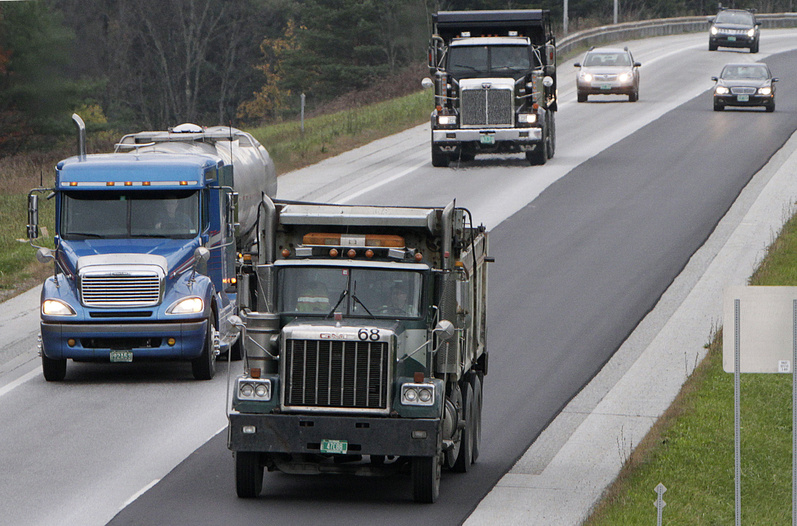PORTLAND — When Brian Souers’ trucks haul logs from northern Maine to mills in other parts of the state, they often drive through small towns on two-lane state highways, even when four-lane Interstate 95 is nearby.
With truck weights limited to 80,000 pounds on Maine’s federal highways, his drivers have to use secondary roads to deliver their loads – forcing them to constantly shift gears, pass through school zones, stop at traffic lights and drive through residential neighborhoods and downtown shopping districts.
That likely will change now that a compromise has been reached in Congress allowing six-axle, 100,000-pound trucks on interstate highways in Maine and Vermont for the next 20 years.
“For a good portion of the wood, it’ll be a lot safer to transport,” said Souers, owner of Treeline Inc. in Lincoln. “It’ll take less fuel, less time, less wear and tear on the equipment, less wear and tear on the roads. It’s something that should have happened 30 years ago.”
Critics say raising highway weight limits poses a threat to public safety and will result in more damage to interstate highways and bridges that taxpayers will have to pay for. They also claim that raising weight limits in Maine and Vermont is part of the trucking industry’s strategy to raise truck weights everywhere.
“This is essentially an arms race that’s been going on forever,” said Curtis Sloan of the Coalition Against Bigger Trucks, based in Alexandria, Va. “Every time one state decides it wants to raise weight limits for whatever reason – whether it be they favor the timber industry or because the sugar beet haulers want this – it inevitably leads to another state wanting to do the same thing.”
Federal law allows trucks up to 80,000 pounds on federal highways, but a patchwork of exceptions allows 50-ton rigs on various highways in different states.
In Maine, trucks weighing up to 100,000 pounds are allowed on the Maine Turnpike section of Interstate 95 from New Hampshire to Augusta, but the limit is 80,000 pounds on other stretches of interstate. State law allows the bigger trucks on state roads.
The result is that the big rigs – the ones carrying logs, cement, gravel, fuel, paper and other heavy loads – have been forced to travel secondary roads that pass through cities and small towns, raising concerns about safety and wear and tear on the local roads.
The federal government enacted a pilot project in December 2009 allowing the heavier trucks onto interstate highways in Maine and Vermont for one year. But the project ended last December, again forcing the heaviest trucks off the interstate and back onto secondary roads.
Sen. Susan Collins, R-Maine, announced Thursday that a compromise agreement had been reached between leaders of the House and Senate transportation appropriations committees to allow the heavier trucks on federal highways in Maine and Vermont for 20 years.
The agreement is part of the 2012 transportation funding bill, which the House and Senate are expected to vote on next week. The bill would then be sent to the president for his signature.
Allowing heavier loads on interstates will improve safety for people who live and work along secondary roads in Maine and Vermont, as well as help businesses remain competitive because it will reduce the time and cost to ship things, Collins said.
For Souers, it is common sense that huge trucks don’t belong on the small-town highways.
“It’s a no-brainer,” he said.
Send questions/comments to the editors.



Success. Please wait for the page to reload. If the page does not reload within 5 seconds, please refresh the page.
Enter your email and password to access comments.
Hi, to comment on stories you must . This profile is in addition to your subscription and website login.
Already have a commenting profile? .
Invalid username/password.
Please check your email to confirm and complete your registration.
Only subscribers are eligible to post comments. Please subscribe or login first for digital access. Here’s why.
Use the form below to reset your password. When you've submitted your account email, we will send an email with a reset code.